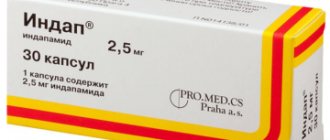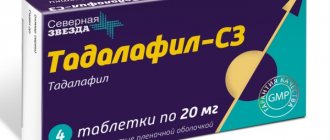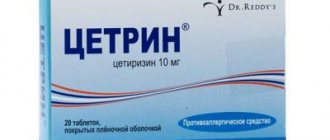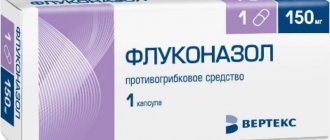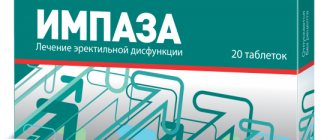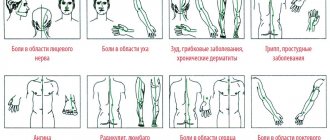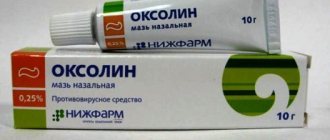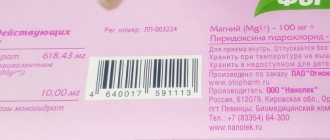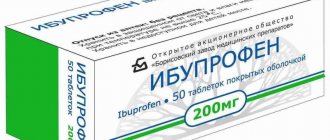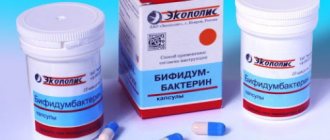Compound
1 capsule of Enterofuril with a volume of 100 mg contains:
- Active ingredient – nifuroxazide 100 mg;
- Excipients: sucrose - 36 mg, MCC - 5.1 mg, corn starch - 41.12 mg, magnesium stearate - 3.78 mg;
- Capsule shell 100 mg (percentage): gelatin - qs up to 100, crimson dye - 0.0077, azorubine dye - 0.0022, quinoline yellow dye - 0.7664, titanium dioxide - 1.3333.
1 capsule of 200 mg contains:
- Active ingredient – nifuroxazide 200 mg;
- Excipients: sucrose – 68 mg, MCC – 9 mg, magnesium stearate – 7.9 mg, corn starch – 65.9 mg;
- Capsule shell (percentage): gelatin - qs up to 100, quinoline yellow dye - 1, titanium dioxide - 2.95.
Release form and component composition
Enterofuril is available in three dosage forms: - In the form of gelatin capsules size No. 2, coated, for convenient use in any situation. The content of the active pharmaceutical substance is one hundred milligrams. The total number of capsules is thirty pieces. — In the form of capsules size No. 0. The content of the main component is two hundred milligrams per capsule.
The total number of capsules is sixteen or thirty-two pieces. — In the form of a suspension, convenient for administration to children. Smells like banana. The content of the main component is two hundred milligrams for every five milliliters. The suspension is packaged in bottles of ninety milliliters. A measuring spoon is included.
The box with the drug contains instructions for use with all the necessary recommendations. Capsules and suspensions contain: - the main pharmaceutical substance - the antimicrobial substance nifuroxazide, which has a wide spectrum of action; — additional substances necessary to give the dosage form in the form of capsules or suspensions; — components of the capsule shell.
The drug Enterofuril for children comes in two main forms: suspension or capsules. The latter are found in two versions. Depending on the quantitative content of the main active ingredient - Nifuroxazide - they are produced labeled No. 0 or No. 2.
Capsules No. 2 contain 100 ml of active substance. They are produced in cardboard packages, each of which contains 3 blisters. Blisters contain 10 capsules, which are hard, opaque, yellow tablets. They are filled with yellow powder, and it is possible that tiny particles of compacted mass may also enter.
Capsules No. 0 contain 200 ml of active ingredient. They are also produced in cardboard packages, which contain 1-2 blisters of 8 capsules in one blister.
Additional components in the tablets are presented:
- corn starch;
- sucrose;
- microcrystalline cellulose;
- magnesium stearate.
Pharmacological properties
Pharmacodynamics
Enterofuril is an antimicrobial agent, is a derivative of 5-nitrofuran, has a wide range of action. It contains a NO2 group. It determines the antimicrobial properties of the active substance, weakens the activity of dehydrogenase and disrupts the production of proteins in pathogenic bacteria. The production of toxins by microorganisms is reduced. The microbial cell membrane is destroyed. Biochemical processes in pathogenic bacteria are inhibited.
The medicine has a bacteriostatic and bactericidal effect. Antimicrobial effect depends on the dose. If it is low or medium, there is a bacteriostatic effect; if it is high, it is bactericidal.
Enterofuril is highly active when confronted with gram-negative enterobacteria and gram-positive microorganisms. The most sensitive are Campylobacter jejuni, Escherihia coli, Salmonella spp., Shigella spp., Clostridium perfringens, Vibrio cholerae, Vibrions and Vibrio parahaemolytique, Staphylococcus spp. Low sensitivity is typical for Citrobacter spp., Enterobacter cloacae and Proteus indologenes. Resistance is observed in Klebsiella spp., Proteus mirabilis, Providencia spp., Pseudomonas spp.
The drug does not affect the saprophytic flora. The intestinal microflora remains in a state of balance, motility also does not change, and constipation does not appear. In the presence of enterotropic viruses, the medicine prevents the progression of bacterial superinfection. When diagnosing bacterial diarrhea in acute form, it helps restore intestinal zubiosis.
The effectiveness of treatment with the drug in the presence of Giardia is 90%. The active substance acts by blocking proteins. And in their absence, the reproduction of Giardia is impossible.
Pharmacokinetics
Capsules are taken orally. They are characterized by a high safety profile. When passing through the gastrointestinal tract, they are not absorbed and do not enter the circulatory system. They begin to affect the body the moment they are in the intestinal lumen. 20% of the drug is excreted unchanged, 80% of the substances are chemically changed. Excretion occurs through the intestines. The color of urine does not change.
Pharmacological action of Enterofuril
The active ingredient, nifuroxazide, is a derivative of the 5-nitrofuran group. It has a depressing effect on pathogens of intestinal infections. Interestingly, small doses of this substance have a bacteriostatic effect - they suppress the activity of pathogenic microflora, inhibiting it. And large doses produce a bactericidal effect, that is, they kill pathogenic bacteria.
Being introduced at the cellular level, nifuroxazide destroys cell membranes, disrupts cytoplasmic conductivity, and inhibits the synthesis of enterotoxins. Irritation of sensitive receptors decreases, the secretion of digestive juices that are released into the intestinal lumen decreases.
One of the positive qualities of Enterofuril is that the active substance does not affect the beneficial intestinal microflora - that is, after its use there is no fear of the development of dysbiosis. The activity of the immune system increases due to increased phagocytosis.
Enterofuril is effective against the following strains of pathogenic microorganisms:
- Staphylococcus (Staphylococcus spp.);
- Streptococci (Streptococcus spp.);
- Salmonella (Salmonella spp.);
- Klebsiella spp.;
- Clostridia (Clostridium);
- Pathogenic strains of Escherichia coli (E. coli) and many others.
The use of the drug does not cause resistance. The drug is excreted in feces and is not absorbed in the stomach.
Indications for use of Enterofuril
Enterofuril is taken for acute bacterial diarrhea.
- acute and chronic diarrhea provoked by pathogenic microorganisms susceptible to the action of the drug (except in cases where the patient has signs of helminthic infestation);
- chronic diarrhea in patients with inflammation of the mucous membrane of the large intestine;
- diarrhea resulting from uncontrolled use of certain antimicrobial drugs (for example, antibiotics);
- diarrhea of unknown origin (both acute and chronic).
The situation should not be aggravated by poisoning of the body, high body temperature, or deterioration of health.
Contraindications and side effects
It is not recommended for a four-year-old child to take Enterofuril and is contraindicated in conditions such as:
- High individual sensitivity to the main and auxiliary components of the drug;
- Insufficiency of enzymes for the absorption of fructose, glucose-galactose malabsorption syndrome, deficiency of the enzyme sucrase, necessary for the breakdown of sucrose.
In addition, Enterofuril in capsule form should not be taken by children under 3 years of age. From 1 month of life to the age of three, it is better to give children a suspension. Enterofuril is not prescribed to babies under one month old. The drug is contraindicated in premature babies with low birth weight. For old and elderly patients, dosages are reduced.
Enterofuril for Children
The medication is suitable for the treatment of childhood diarrhea. It is allowed for patients over 3 years of age. For children under 3 years of age, the medicine is prescribed only by a doctor. The treatment is carried out under the supervision of a specialist.
Enterofuril with caution
Taking the medicine should be accompanied by constant monitoring of health status if a person is diagnosed with liver or brain pathology. Compliance with precautions is mandatory when breastfeeding, alcoholism, traumatic brain injury, or taking medication in childhood.
Enterofuril, instructions for use (Method of application)
Capsules are taken orally before or after meals (the severity of the effect does not depend on food intake). It is best to drink them with water. The duration of therapy is limited to 1 week. The single dosage is unchanged - 200 mg (1 capsule 200 mg or 2 capsules 100 mg each). The patient’s age determines the daily dose, frequency and number of doses:
- Children 3-6 years old take 200 mg three times a day with an interval of 8 hours;
- Patients over 6 years of age take 200 mg 3-4 times a day, the duration of the break varies from 6 to 8 hours;
- Adults are prescribed 200 mg four times a day at 6-hour intervals.
Typically therapy lasts 5-7 days. If there is no progress in the first 3 days, you need to visit a doctor. He will decide on the advisability of such treatment, taking into account the effectiveness of the drug. The drug is used in the manner and in the dosages specified in the instructions. Deviation from the standards described above is unacceptable. To avoid negative consequences of drug therapy, you can consult a specialist before using the medication.
The medication acts immediately as soon as it reaches the intestinal lumen. How long the activity of the main substance will last depends on the motility of the intestinal tract and the dose taken. These indicators also determine the rate of removal of medicinal components from the body.
Rules of application
Capsules and suspension are taken orally. Capsules are available in two dosages: 100 mg and 200 mg. For children over 7 years of age and adults, a therapist or pediatrician usually prescribes 800 mg of Enterofuril per day. This dose should be divided into 4 doses. Children from 3 to 7 years old should be given 200 mg of the drug three times a day.
The box with the suspension contains a 5 ml measuring spoon. The bottle should be shaken before taking the solution. The recommended dosage for children from the first month of life to six months is half a scoop of Enterofuril twice a day. A child from six months to 2 years old can be given the same dosage, but three times a day. Older children are prescribed 5 ml 3 times a day. The duration of treatment with capsules and suspension should not exceed a week.
Enterofuril dosage for children aged 4 years is 600 mg per day, divided into three doses (morning, lunch and evening).
Enterofuril during pregnancy and lactation
As part of the research, the drug was tested on animals. According to the results of the experiment, no teratogenic effect was found. Despite this, doctors do not recommend using the drug during pregnancy for safety reasons. In exceptional cases, the drug may be approved for pregnant women. This step is associated with the predominance of the benefits of therapy over the potential risk for the unborn child.
When breastfeeding, a quick course of treatment is allowed after consultation with a doctor. After completion of therapy, the lactation period can be continued.
special instructions
Taking nifuroxazide and treating diarrhea require rehydration therapy. If an illness occurs in a child under 3 years of age, treatment is carried out under the close supervision of a doctor. If the course of the disease is characterized by deterioration in health, infection, poisoning, or high fever, the question of the advisability of including systemic antibiotics in therapy is decided by the attending physician.
The medicine does not combine with alcohol. As part of drug therapy, drinking alcoholic beverages is prohibited. If during treatment signs of hypersensitivity (itching, rash, shortness of breath) appear, use of the drug should be stopped. Enterofuril can provoke allergies. In exceptional situations, reactions may appear some time after the end of the course, when a sufficient amount of allergen has accumulated in the body.
Information on the volume of sucrose in a 100 mg capsule:
- 1 capsule contains 36 mg of sucrose, which is equal to 0.0030 XE;
- 2 capsules (single dose for all patients) is 0.006 XE;
- The daily dose for children 3-6 years old (frequency of administration - 3 times a day) has an indicator of 0.018 XE;
- The daily dose for patients over 6 years of age (with 4 doses) is 0.024 XE.
Data on sucrose in 200 mg capsule:
- 1 capsule - 68 mg of sucrose, which is 0.0056 XE;
- The daily dose for children 3-6 years old (with 3 doses) reaches 0.0168 XE;
- The daily dose for patients over 6 years of age (with 4 doses) is 0.024 XE.
Impact on the ability to drive vehicles and other mechanisms
The speed of human reaction and the functioning of the central nervous system remain unchanged. The patient is able to drive a car, other vehicles and machinery in a standard manner.
Enterofuril - contraindications, side effects
Contraindications.
Hypersensitivity to nifuroxazide, other 5-nitrofuran derivatives or other components of the drug.
Adverse reactions.
Temporary abdominal pain, nausea, vomiting, and increased diarrhea may occur.
Allergic reactions are possible, including itching, skin rashes, urticaria, Quincke's edema, anaphylactic shock. The occurrence of an allergic reaction requires discontinuation of the drug. In the future, the patient should avoid taking nifuroxazide and other nitrofuran derivatives.
Medical professionals, patients, pharmacists are asked to report any suspicion of adverse reactions or lack of therapeutic effect by email to the representative office of Bosnalek d.d.

